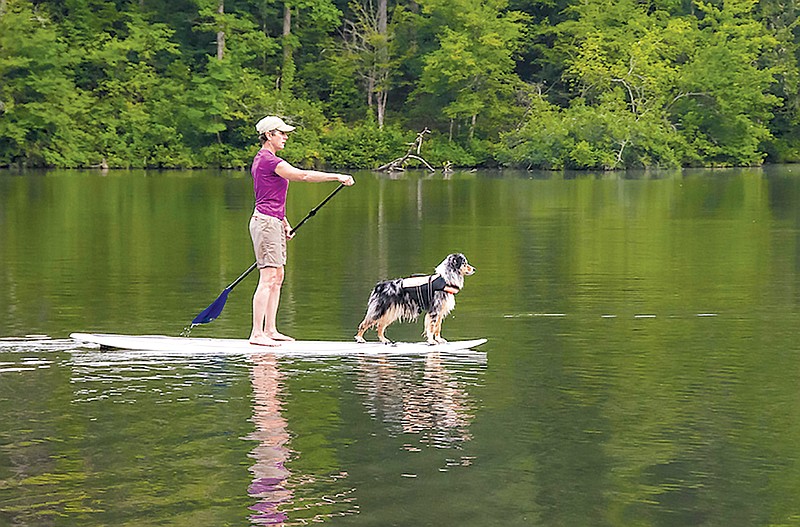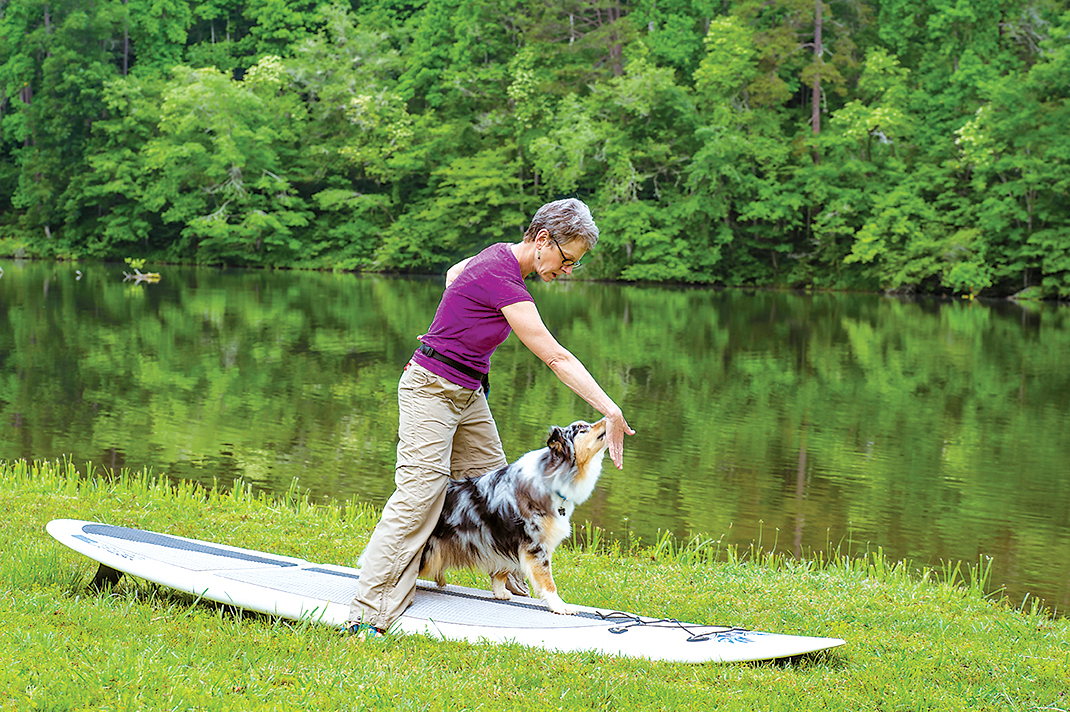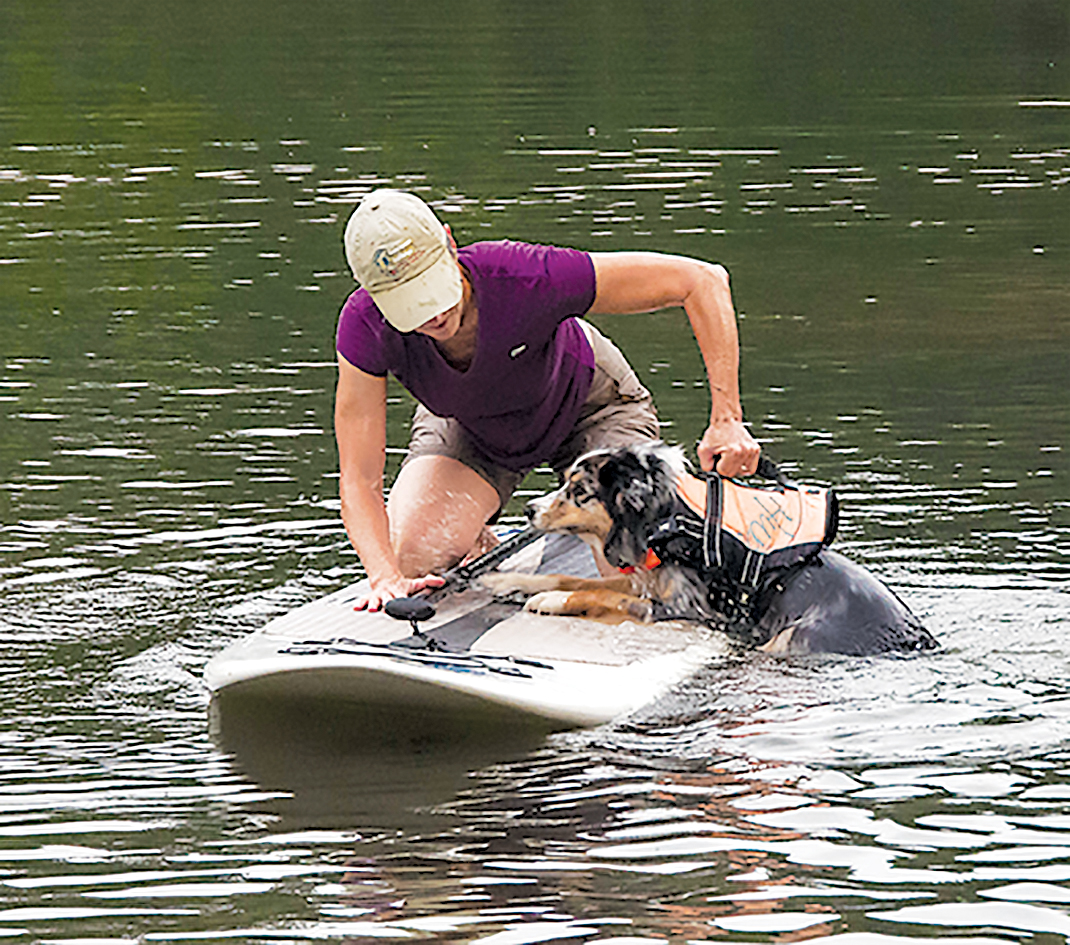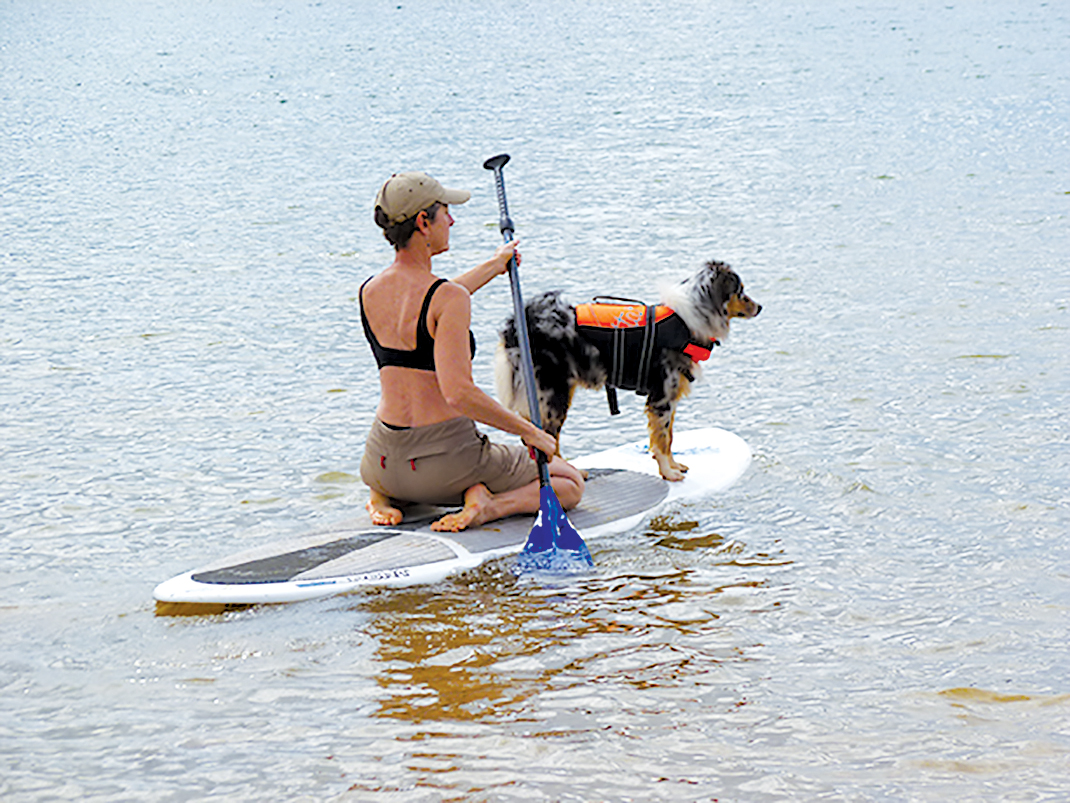As a former avid whitewater kayaker, when I first saw photos of people on stand-up paddle boards I thought, "Why in the world would anyone want to do that?" Where was the excitement? The adrenaline?
Fast forward a few months to when a girlfriend twisted my arm to give stand-up paddle boarding a try on the Tennessee River. I am a water-loving girl, after all. I quickly realized this sport was much more fun than it looked in all those photos I'd seen. All of us who tried it that day enjoyed the exercise and the view from the standing position on the board. I also happen to have a water-loving dog, and I immediately saw this as something Willow and I could enjoy together. I was hooked.
If you like the outdoors and your dog enjoys water, SUPing is a fantastic way to spend time together. The added bonus is that it's great exercise for both of you. Standing and balancing on the board while paddling seems to work every muscle in my body, and so it must be with my dog's body, too. But it's not all work and no play. If you tire of paddling, just plop yourself down on the board and take a break. Or hop off and take a swim with your dog. It doesn't get much better.
SUPing is a relatively easy sport with just a few equipment needs - and some basic skills.
Easy ones first. Your dog must:
Love the water: Many dogs naturally take to water and swimming, so if your dog already loves the water, fantastic. If not, find a lake or pool with a shallow area and bring out the fun! Pair the new experience of two or four paws in shallow water with an enjoyable game of tug, or feed your dog high-value treats while his or her paws are in the water. Don't ever push or throw your dog into the water. Dogs are always making decisions about what's safe and what's not, so make sure your dog has a pleasant experience near and in the water.
Be able to swim: Swimming didn't come naturally to Willow, though you wouldn't know that to watch her now. Once Willow was comfortable wading in shallow water, I cradled her under her belly, let her dog-paddle for a few seconds, then quickly set her back down where her paws could touch the bottom. I also used friends' water-loving dogs to encourage Willow into the water. Always remember to work at your dog's pace.
Safety first:
Before you ever invite your dog to join you, it’s imperative that you are comfortable on your board and practice falling off and getting back on. The more experience you have with practice falls, the better you’ll be when the unexpected happens. I strongly advise you to always have your dog wear a life jacket, no matter how well s/he swims, since you may be paddling far from shore. If you take an unexpected fall, be sure your furry friend is safe. Check the weather forecast before you head out. Take the right clothing for the weather, and always remember water for you and your dog.
Now for the foundation.
Before SUPing with your dog, s/he should have mastered basic foundation skills such as "sit," "down," targeting, "wait" and "come." This last one is extremely important, since your dog will be off leash before, during and immediately after your SUPing adventures. If you've already done some shaping with your dog, your shaping skills will come in handy.
"Targeting" is teaching a dog to touch a hand or an object with a part of their body. Shaping is breaking a finished behavior down into tiny parts and reinforcing each step toward the final goal behavior.
Next up, you need to teach your dog to love your board and your paddle.
Introducing your dog to your board and paddle is where classical conditioning comes into play. You want your dog to develop a positive association with your SUP and paddle and to think the board is the best toy in the universe. To your dog, the SUP is a new, unusual piece of equipment, as is the paddle. Many dogs, including our older Aussie Cody, shy away from a long paddle when it's held in a vertical position. Go slowly during the introduction period, and move at a pace that's comfortable for your dog.
Because Willow is such a confident dog and was only 8 months old when I began teaching her, it took just a few short sessions for her to become comfortable with the equipment. However, if your dog adjusts slowly to new, unusual things or environments, you'll need to spend as much time as necessary for your dog to show you through his or her exuberance that they loves the board. You know that "whoopee!" look you get when you pick up your dog's leash? That's the look you should get when you pull out your board.
Here's how to get there with some at-home training.
Inside: If you have room, place your SUP and paddle inside your home in an area where your dog already enjoys spending time with you. This is a great way to pair fun experiences with your new SUP. You can play games with your dog near the board, have fun training sessions near the board, let your dog enjoy a stuffed Kong toy beside or on the board, and even feed your dog meals from a bowl on the board.
Do the same exercises with the paddle. When it's time to pick up the paddle and hold it vertically, enlist the help of a friend to hold and move the paddle while you feed your dog treats or play games with him or her around the moving paddle. Our home is so small that bringing the board inside wasn't an option, so I did all these things outdoors.
Outside: Once your dog is comfortable with the board inside, it's time to do some training outside. Work first with your dog on the board on dry land. I'm a clicker trainer, so I use the sound of a clicker to mark a behavior I like, then I reinforce the dog with a yummy piece of food. I also do a lot of shaping. The training technique of shaping helps a dog learn to interact with new objects.
Because I've done so much shaping with Willow, when I first placed the board on the grass, she immediately began interacting with it. I merely clicked and treated her for any interaction with the board (a sniff, a nose touch, a paw up, etc.), and before long she was readily hopping onto the middle of the board. Once your dog is comfortable moving on and off the board, add a cue to get on the board and a cue to get off. My hop-on cue is, "surf's up," and my get-off cue is "off."
Targeting comes in handy.
Stand-up paddle boarding demands balance for both you and your dog. You are most stable when you're standing near the middle of the board and your dog is positioned in front of you.
I've used both nose targeting and body targeting to teach Willow where to be on the board. I taught her a cute trick (on dry land) so that when I cue her with "peek!" she comes from behind me through my legs and sits.
Because she'd already nose-targeted my hand, I merely stood with my legs wide apart, placed my target hand in front and in the middle of my legs, and cued her to target my hand. Once she was reliably moving through my legs and into a sitting position, I added the cue "peek!" This exercise came in handy when SUP training on land to help me position her body. It was also incredibly useful when we made our maiden voyage - on flat water - as she wandered about the board, making it challenging for me to balance. Having her target my hand was an easy way to position her.
Gear tips
» Boards with extended deck pads are preferable so that your dog has a safe, non-slick area for his or her paws. If the deck pad doesn’t extend to the bow, a textured surface on the bow is preferred, though you can add deck padding to either a textured or slick bow. Length/weight of the board depends on your weight plus your dog’s weight.» A safety leash or tether for your board is recommended in any type of moving water or in ocean surf. If you fall off, the ankle leash will keep your board near you. Coiled and uncoiled leashes are available.» In your first aid kit, be sure to include your dog’s vaccination records and your vet’s contact information along with your personal emergency contact info.» This may seem silly since you’ll be surrounded by all that water, but be sure to bring some fresh water for both you and your dog. Collapsible dog bowls are a man’s best friend.
Targeting also can be useful to help teach your dog where his or her entire body should be. In essence, you're body targeting. Teach your dog to sit and wait with his or her entire body on a mat in your home, outside on your porch, in your yard and on the grass by the lake. Eventually, transition the mat to your SUP. Because your dog has learned to sit and wait on the mat in a variety of places, the exercise should transfer well to your SUP. Begin with a mat large enough to fit your dog's entire body, then decrease the size of the mat by cutting it into smaller and smaller pieces, until you fade it out entirely.
Practice the balancing act.I've had Willow on all manner of wobbly, rolling surfaces since she first entered our home at 9 weeks of age, so she already had good balance and was comfortable on a variety of moving surfaces before I started SUPing. You must help your dog become comfortable with a moving surface prior to beginning board work on the water. A couple of fun training options are a wobble board and a FitPAWS Balance Disc. Be creative. When traveling and staying in hotels, I had Willow hop up on the rolling luggage cart and fed her yummy treats as I slowly rolled the cart around.
Hit the water! (Though it's not all smooth sailing just yet.)
Once you're certain your dog is comfortable and has a positive association with the board, the paddle and moving surfaces, it's time for the water work.
Choose a nice, warm, sunny, calm day on a flat water surface. We're fortunate to live near many beautiful lakes, but even a small pond can work. Begin with the board partially in the water and partially on land. Cue your dog to get on the board and feed him or her yummy food the entire time s/he's on the board. Then cue the dog to get off, and stop the food so that your dog understands that being on the board makes good things happen. Of course, verbally praise your dog, too.
Make the dog's time on the board only seconds at first, then slowly increase the length of time the dog is on the board, but only if s/he is comfortable. You want your dog to have a positive experience, so go slowly. If at any time the dog seems uncomfortable, move back to dry land beside the water and continue there until your dog has that "whoopee!" look.
Once your dog is comfortable with the board partially in the water, place the board fully in shallow water (avoiding any rocks or hard surfaces). While steadying the board with your hand, cue your dog to get on the board. Be fun, upbeat and praise your dog as you slowly move the board around. If s/he hops off before you cue him or her to do so, no worries. Just begin again and eventually s/he'll get the hang of it. If at any time your dog seems uncomfortable, go back to where the dog was last happy and successful and spend more time at that step before proceeding.
Next, sit on the board with your dog and paddle about. Then kneel on the board and paddle about. Once your dog is comfortable riding the board with you kneeling and paddling on flat water, it's time to stand up. Standing and balancing with your dog on the board is a new challenge for both of you. Either one of you could lose your balance and fall off, so why not practice by doing some fake falls and making it a fun experience for both of you? That way, when the unexpected fall happens, you'll both be better prepared.
When you're ready to stand, come up onto all fours (both knees and both hands), positioning your knees on either side of the SUP handle in the middle of the board. Your paddle should be perpendicular to the SUP and your palms should be on the paddle. Come up on one foot, then the other, by bringing your feet toward your hands. If you're feeling a bit wobbly, your dog is, too, so continue to be upbeat and praise your dog for being "the best dog in the whole world!" Be prepared to shift your position on the board in response to your dog's movements. Ideally, both you and your dog will stay in one spot on the board. Make your maiden voyage very short, praising your dog the entire time, then return to your knees before getting off the board. This position provides more stability for both you and your dog.
Ready to give it a try?
No need to run out and buy a board right away. It’s a significant investment. Take advantage of a day’s rental and find out how fun SUPing can be. Start honing your skills on the water while you’re doing dry land training with your dog, and before you know it you’ll be SUPing into the sunset with your favorite furry friend on board.PLACES TO TRY:Beginner: Chester Frost ParkIntermediate: Chickamauga Dam swim area off Highway 153Advanced: Tennessee River through downtown Chattanooga
Happy SUPing!



